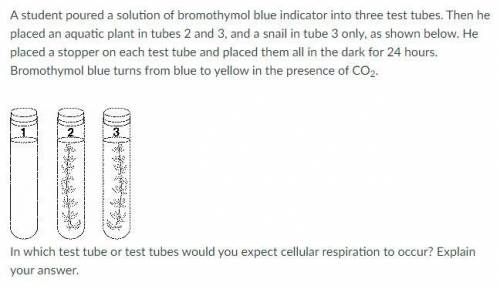
Biology, 12.11.2020 05:20 dianacastro8298
A student poured a solution of bromothymol blue indicator into three test tubes. Then he placed an aquatic plant in tubes 2 and 3, and a snail in tube 3 only, as shown below. He placed a stopper on each test tube and placed them all in the dark for 24 hours. Bromothymol blue turns from blue to yellow in the presence of CO2. In which test tube or test tubes would you expect cellular respiration to occur? Explain your answer. Please, hurry!


Answers: 1
Another question on Biology

Biology, 22.06.2019 01:00
Some mining processes involve removal of large areas of earths surface in the mined region this practice causes severe environmental damage by allowing which natural process to accelerate in the affected areas? a.precipitation b.erosion c.migration d.condensation
Answers: 1

Biology, 22.06.2019 04:00
Indicate the coat color and the proportion of offspring with that color for each of the following crosses of rabbits. assume all are homozygous. chinchilla x albino a) all chinchilla b) 1/2 chinchilla, 1/2 albino c) 3/4 chinchilla, 1/4 albino
Answers: 1

Biology, 22.06.2019 06:30
Study the picture of the ocean. which is the best example of an organism’s niche shown in the picture? a. the environment contains several of the same species of coral. b. the shallow area of the ocean meets the needs of the coral and the fish. c. the ocean has fish and coral that live in the same area. d. the coral take in food from the water and provide shelter for the fish.
Answers: 2

Biology, 22.06.2019 06:50
The kidney filters potentially toxic substances in the blood, and thus “clears” the blood of those substances. this clearance function is dependent upon and proportional to the diffusion gradient of the substance across filtering capillaries, i.e. if the concentration of the substance is doubled, twice as much will be cleared from each ml of blood that is filtered. suppose that the body produces a constant amount of a substance x per unit of time. the kidneys eliminate substance x at a rate directly proportional to the concentration of the substance and the volume of blood cleared each minute (c): elimination = c × [x], where [x] is the steady-state concentration of substance x. imagine an individual with an initial concentration of x equal to [x]0 who develops kidney disease. her baseline clearance c0 drops to one half of the original (½c0). what is the new steady state concentration of x? (for simplicity, assume that substance x is 100% filtered by the kidney).
Answers: 1
You know the right answer?
A student poured a solution of bromothymol blue indicator into three test tubes. Then he placed an a...
Questions

Chemistry, 22.07.2019 01:30



Mathematics, 22.07.2019 01:30



Biology, 22.07.2019 01:30




English, 22.07.2019 01:30



Mathematics, 22.07.2019 01:30


Mathematics, 22.07.2019 01:30



Mathematics, 22.07.2019 01:30

Biology, 22.07.2019 01:30



